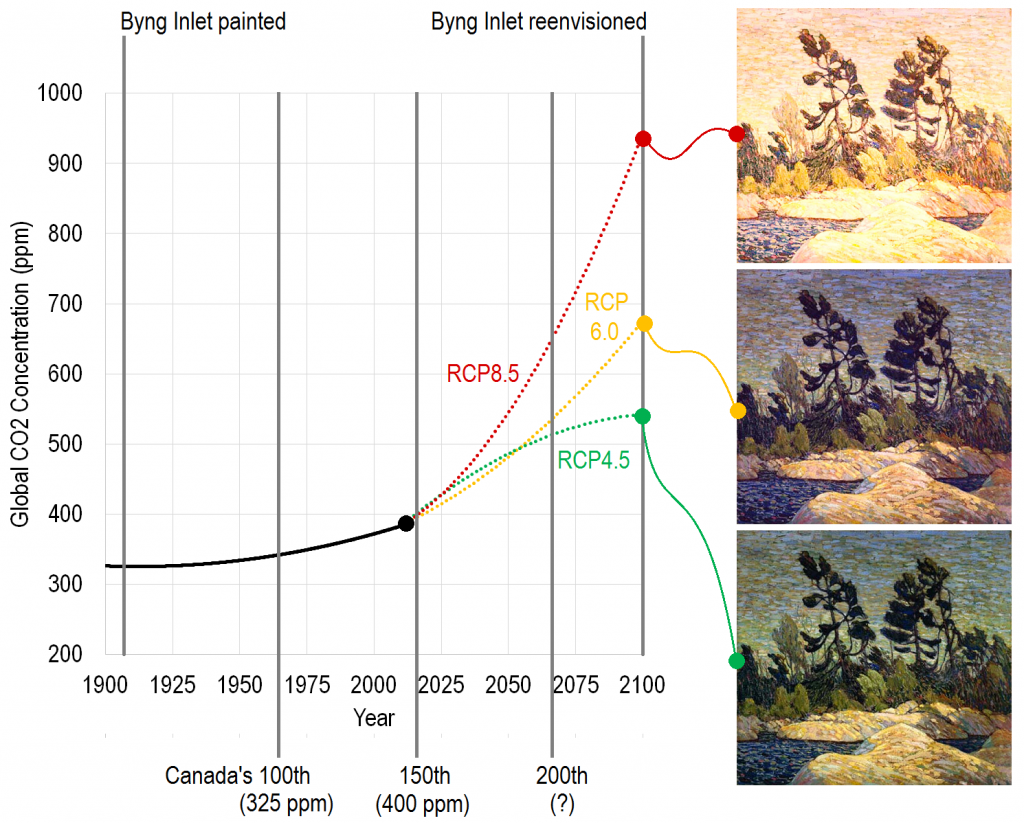In collaboration with Virginia Eichhorn of the Tom Thomson Art Gallery, I am hoping to get a very interdisciplinary arts and sciences project underway that looks at the impact of recent and projected climate change on the Canadian landscapes painted by the Group of Seven. The exceptionally vivid expressionist landscape scenes painted by the Group of Seven between 1920 and 1935 have become Canadian cultural icons. The temperature and precipitation trends associated with climate change, however, are changing these landscapes, most visibly through changes in vegetation, snow and glacier extent, lake or sea ice extent, and flood or drought frequency (Figure 1). We intend to reframe Group of Seven paintings as unique time capsules of a vanishing Canada, rather than portraits of an intransient Canada.

Figure 1 – Highly visible landscape change at Mount Robson due to air temperature change. Red shading denotes glacier area change since Lawren Harris originally painted this scene c. 1930.
To do this, we are seeking to dispatch contemporary emerging artists across Canada, to landscapes featured in Group of Seven works, to re-paint impressions of these landscapes under one of three IPCC Representative Concentration Pathways (RCPs). These RCPS, ranging from RCP 4.5 to RCP 8.5, essentially range from “optimistic” to “pessimistic” CO2emissions reductions scenarios. For example, RCP 4.5 simulates 4.5 W/m2 increased radiative forcing in year 2100 relative to year 1850, while RCP 8.5 simulates 8.5 W/m2, or almost twice as much, anomalous radiative forcing associated with well-mixed greenhouse gases from anthropogenic sources.

Figure 2 – Envisioning a landscape in 2100 under three IPCC scenarios that vary from the “optimism” of RCP 4.5 to the “pessimism” of RCP 8.5. Byng Inlet was originally painted by Tom Thomson c. 1920.
We are ultimately aiming for a cross-disciplinary arts and sciences exhibition that will place specific Group of Seven landscapes, and more broadly Canada’s landscape, in the context of ongoing climate change in a highly visual fashion. Inspired by ArtTracks150, we are hoping that Canada’s 150th birthday (July 2017) may provide a natural window of increased public awareness of centurial time-scales, during which we might briefly focus public attention on the multi-generational implications of climate change on the Canadian landscape. Virginia and I welcome you to contact us for more information on, and ways to get involved with, this project.
Interested in #climate change and iconic #GroupOfSeven landscapes?
http://t.co/3dhYqJlCx6 @partnersinart1 pic.twitter.com/mla4CxFBk5
— William Colgan (@GlacierBytes) August 2, 2015
